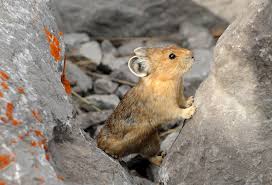Upland Pika
The pika, a small mammal closely related the rabbit, is native to the cold northern regions of Svalskogenhiem being found in both the high altitudes of mountain ranges and the tundra. There are 12 species spread across the arctic and subartic regions, though the most successful and widespread in Svalskogenheim is the Upland Pika.
Basic Information
Anatomy
Like all pika, the Upland pika has short limbs, a very round egg-shaped body and no external tail. Unlike their close relations rabbits, their hind limbs are not significantly longer than their front. They have soft dense fur, that covers all of their bodies including the soles of their feet. Fur colouration for all species of pika is agouti, but the Upland Pika is the only species that both alters its colouration dependent on its environment, and seasonally as well, changing to a spotted or speckled white pattern, or even a full white back in snowy conditions.
It is also one of two pika species that secrete a waxy substance from its sebaceous glands that coats its fur, providing both an element of waterproofing and allowing the fur to trap more air for warmth.
The Upland Pika is unusual in that releases a strong poison into its organs as it dies via two crural glands located internally near the upper thighs.The poison seems to stay potent for around a day after its death, thus being intended to prevent predation.
Genetics and Reproduction
Typically the Upland Pika will have one litter of between 3-9 young in a season, with an occasional second litter if there is a plentiful food supply and the first littler was unsucessful.
Ecology and Habitats
Upland Pikas can be found in alpine mountainous habitats, as well as tundra steppes and taiga. Though it is found more commonly in the higher altitudes sheltering among the rocky crevices of scree and talus, the Upland Pika (unlike all other species of pika) can equally be at home creating a burrow on the tundra, or in fallen trees and vegetation of alpine forests.
Dietary Needs and Habits
The Pika will feed on almost any plant matter, such as roots, grasses, lichens, forbs and moss.
Additional Information
Domestication
Although too small, timid and short lived to be domesticated the Upland Pika can at least be tamed enough to tolerate the presence of humans.
Uses, Products & Exploitation
The waxy secretion, named Ullinol by the Krovast, is collected from the pika though a combination of bathing and combing the pika. Once several animals have been combed the remaining water is boiled off, leaving the ullinol behind. Ullinol is used as a skin treatment for burns, rashes, infections and for the regrowth of skin around wounds.
As the animal is easily stressed by handling, care must be taken to limit the time it is held for; combined with their small size this limits the production of ullinol to very small batches.



